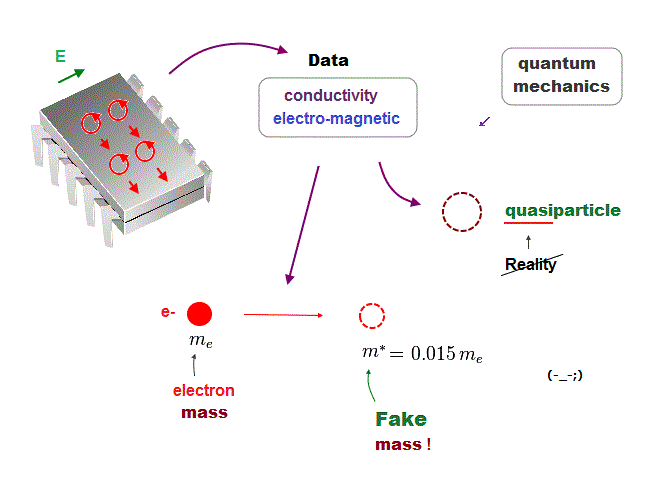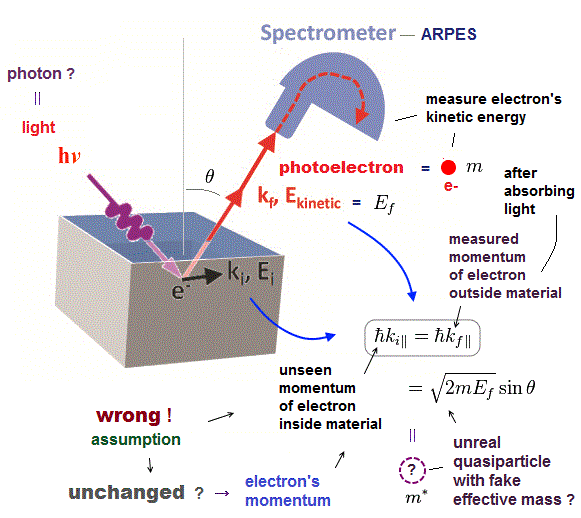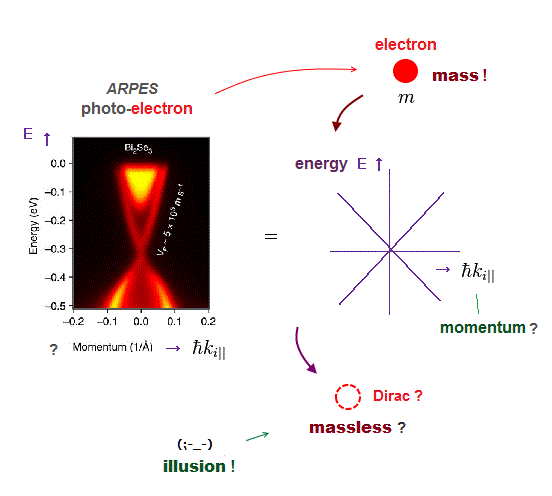
(Fig.1) Quantum mechanics uses unreal quasiparticles, effective mass.

The present only atomic theory called quantum mechanics is useless, treating materials and molecules as fictional quasiparticle model with fake effective mass.
(Fig.2) Quasiparticle contradicts basic physical principle.

The present quantum mechanical research has relied on very old methods called ARPES (= angle resolved photoelectron spectroscopy ) to wrongly assume electrons inside materials are fictional quasiparticles with fake effective masses just by measuring real electrons ejected by light.
For example, physicists wrongly assume electrons inside some material called topological insulators behave like (fictional) massless quasiaprticles called Dirac or Weyl fermions, based on ARPES ( this-1st~10th-paragraphs ).
↑ These fictional massless Dirac quasiparticles are unphysical, because they move much slower than light despite the zero mass.
(Fig.3) They misunderstand the electron's momentum in ARPES. → unreal quasiparticle with fake effective mass

Angle-resolved Photoemission Spectroscopy (= ARPES ) tries to (wrongly) guess fictional electrons' energy and momentum inside material by measuring the kinetic energy and momentum of (real) electrons with real mass kicked out of material after the electrons absorb incident light using photoelectric effect to infer unreal quasiparticle model.
The interpretation of this ARPES is based on wrong hypothesis that the (unmeasurable) electron's momentum (= p = ℏk|| ) parallel to the material's surface may keep the same value, even after the electron absorbing the incident light and changing its kinetic energy is kicked out of material ( this p.6-7, this p.27, this p.4-(4) ).
↑ Electrons absorbing the incident light energy change their kinetic energy, but paradoxically do not change their momentum ? ← This wrong ARPES assumption originated from the wrong quantum mechanical hypothesis that real electrons can absorb only unreal virtual photons with imaginary mass, when total energy and momentum are conserved.
Furthermore, to estimate the (unseen) vertical momentum (= k⊥ ) of an electron inside material, they rely on a unknown freely-adjustable parameter V called inner potential, which is different from binding energy or work function ( this p.3-(9), this p.12, this p.32 ).
↑ This unknown parameter V or inner potential in ARPES can be freely chosen to match any fictional theories or unreal quasiparticle's model with fake effective masses such as fictional massless Dirac fermion theory (= unreal quasiparticle, this p.1-abstract, this-p.4-Fig.2 ).
↑ This wrong assumption of ARPES is one of reasons why quantum mechanics intentionally misinterprets electrons inside materials as fictitious quasiparticles (= such as massless Dirac fermion quasiparticle, this p.8-10 ) with fake effective masses m* ( this 2~3rd-paragraphs, this p.4-lower, this p.2-right, this p.2-right ), even after ARPES measures the real electrons with real mass.
Spin-ARPES just measures electrons scattered by magnetic material, which can Not measure the fictional electron spin itself.
↑ The unreal electron can be replaced by the real electron's orbital motion whose direction can naturally influence the direction in which electrons are scattered.
(Fig.4) ARPES wrong assumption about momentum causes unreal "massless" Dirac quasiparticles.

Based on the wrong assumption of ARPES measurement, physicists imagine fictional momentum, energy and fake effective mass of quasiparticles inside material in the unphysical band theory ( this-p.5, this-p.2-3 ).
Kinetic energy of a particle with mass is proportional to the square of momentum.
On the other hand, the energy of massless light (= photon ) is known to be linearly proportional to momentum ( this p.7 )
By wrongly guessing the unknown momentum of ejected electron based on problematic ARPES, physicists estimate the relationship of energy linearly proportional to momentum in the fictional massless Dirac fermion (= unreal quasiparticle ) inside solids.

Feel free to link to this site.